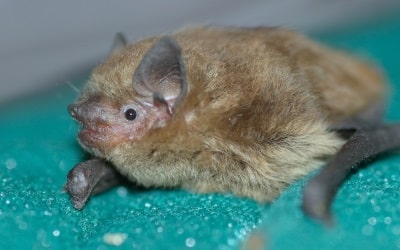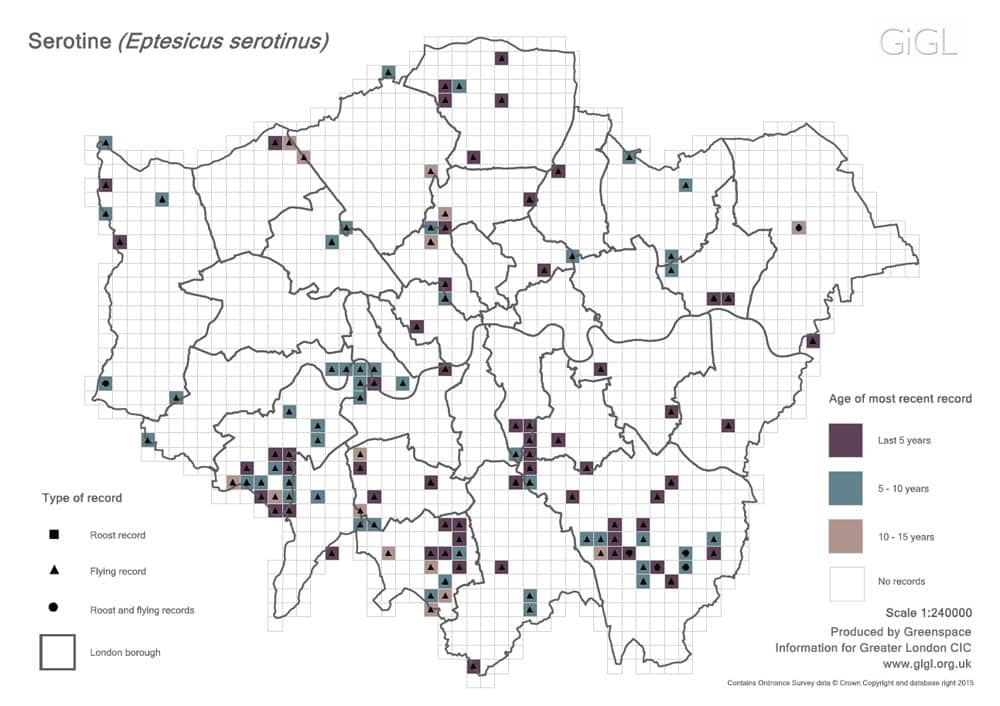Richard Gowing, London Bat Group

Common pipistrelle, © Alison Fure
The nocturnal habits of bats make them intrinsically difficult for human observers to study. In Greater London, those interested in discovering more on the ecology and conservation status of bats face additional obstacles. Firstly, there is a lot of inaccessible, privately owned land. Secondly, Greater London is a huge area to cover. Finally, London is generally a safe city, but there are some areas that should be avoided when undertaking night-time field work.
These constraints make it hard to pin down some basic aspects of bat ecology in London such as: the number and location of different species; any patterns in their distribution; and which species are genuinely uncommon or rare in London and which are simply under recorded or hard to find.
Finding answers to some of these questions is very important as London’s bat population faces many pressures, including degradation of feeding areas and movement routes caused by light pollution, loss of habitat and roosting sites through development and inappropriate management of green spaces.
It was around 2010 that the London Bat Group began to think about doing something to address this situation. At London Bat Group’s disposal is a database of 27,000 records from 1985 to the present day, gathered by an army of London Bat Group members over the years. This is in addition to the thousands of records contributed by other members of the GiGL partnership. These records include evidence of bat foraging areas, bat roosting sites and bats found grounded by members of the public or rescued by Natural England volunteers. However, raw database records in themselves are of little use without some sort of analysis. To be of use to those making decisions which affect bats in London (town planners, ecologists and land managers etc.), the data needed to be summarised in an easy to understand format. The solution – publish a London Bat Atlas.
The project was driven forward by the tireless efforts of a number of London Bat Group members: Alison Fure (the project instigator), Richard Law (the atlas author) and Derek Coleman (the London Bat Group records officer) to name but a few.

However, the atlas would not have been possible without the valued support of the team at GiGL, who were able to produce detailed distribution maps at 1km grid-square resolution.
The maps make good use of different colours to show data originating from different time periods. They also differentiate roost records from other evidence of bat activity by using different symbols. The maps are an example of how multi-facetted ecology information can be visualised in a clear, concise way and in an aesthetically pleasing format.
The atlas has already shown quite a few interesting trends. For example, the instance of the serotine bat seems to be concentrated to the south of London; Leisler’s bat roosts appear to be highly localised; and certain rare bat species have not been recorded in London for many years (e.g. barbastelle and Bechstein’s bat) despite potentially suitable habitat being present in some outer London areas.
The London Bat Group hopes to use The Bat Atlas of London to galvanise support for bat conservation in the capital. Copies have been sent to all London authority planning departments and are available free-of-charge. We also hope to use the atlas to direct survey effort to areas of London where there are gaps in our knowledge of bat distribution and status.
A copy of The Bat Atlas of London is available to download here. If you have any questions or comments please contact enquiries@londonbats.org.uk.
Richard Gowing has been involved with the London Bat Group since 2007 and Chair of the group since 2013. He first became interested in bats as a child, on night-time walks with his father in Suffolk. Since then, they’ve become a subject for study, and eventually part of his job as a consultant ecologist for a large engineering company. He says the London Bat Group are keen to encourage new members, carry-out survey work to reveal how bats are distributed across London, and seek to secure protection of important bat roosts.
